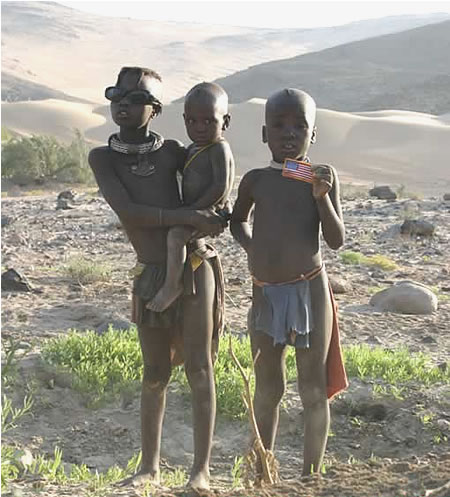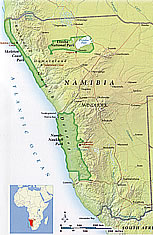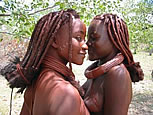![]()
Namibia's Himba People

Vacationtechnician personalized luxury adventure travel transports you to the most exquisite wilderness and chill out retreats on Earth. Conserving rare biodiversity through low volume tourism; our aim is your indulgence -at no one's expense. Plan now to be assured a rejuvenating escape at a restful pace -to an unspoilt gem in the purest sense.
![]() Namibia
Safari Field Reports
Namibia
Safari Field Reports
![]() Meet our expert Safari Guides
Meet our expert Safari Guides
" best guides = best safaris ~ a bad guide in the best camp will ruin your safari."
![]() World Watch Advisory 03/17/04
04:54 GMT
World Watch Advisory 03/17/04
04:54 GMT
Authorities warn March 16 2004 that serious floods are likely in northern
Namibia in the coming weeks. Namibian Department of Water Affairs
officials March 16 warned that impending floods in the Caprivi Strip in northern
Namibia are likely going to exceed those seen in 2003 - which was described
as a major disaster. Anticipate significant disruptions including road closures
in this region in the coming weeks.
Officials have been reporting rising river levels in the Zambezi and Kavango rivers since mid-January. The water level in the Zambezi River March 14 was measured to be at least 1.6 meters higher than last year's level taken at the same time. Authorities estimate that additional rains in southern Angola are likely to push the levels well beyond those experienced in 2003 when floods submerged large parts of the Caprivi Strip and caused serious population displacements. Fears are even expressed that Katima Mulilo - a major town in the Caprivi Strip - may be flooded. Lake Liambezi in southern Caprivi has already begun flooding. Significant flooding may impact the major east-west road running through the Strip connecting Namibia with Zambia and Zimbabwe.
Expect disruptions in road travel and public services, including power outages; allow additional time to reach destinations. Consider postponing road travel to and through affected areas. If travel is unavoidable, carry plenty of food and water, and a radio with spare batteries. A personal satellite locator is also recommended. Avoid driving through water on roadways, as it could cause the vehicle's engine to stall. Do not attempt to move a stalled vehicle; abandon it and immediately move to higher ground.
As always in Namibia, drink bottled water only and use bottled water when brushing your teeth. Flooded conditions may lead to health risks and diseases such as malaria. Monitor media reports for local impact and follow the guidance of local authorities.
____
![]() Namibia's
Himba struggle to maintain control of their life and lands. -National
Geographic
Namibia's
Himba struggle to maintain control of their life and lands. -National
Geographic
When drought and war struck Namibia in the 1980s, it looked as if the culture
of the indigenous Himba people might disintegrate. Ninety percent of Himba
cattle, the center of their economy and identity, died. Some families left
for Angola. Lacking any other means of survival and desperate for cash, a
number of men joined South Africa's army in its fight against guerrillas seeking
Namibian independence. Unable to feed themselves, Himba flowed into the town
of Opuwo for relief food, settling in slums of cardboard and plastic sacks.
But the estimated 20,000 to 50,000 Himba, long among Africa's most prosperous
herders, are resilient. In the 19th century those in Namibia survived cattle
raids by marauding ethnic groups from the south. Most fled into Angola, joining
with the Portuguese military and forming their own armies of raiders. Eventually
many returned to Namibia. Starting in the 1920s,
South African rulers confined them to a prescribed "homeland," officially
forbidding them to trade, graze livestock freely, or garden and gather wild
plants along the Kunene River. Yet they endured—even if at times it
meant eating the hides they slept on.
With the peace and good rains that came to Namibia in the 1990s, the Himba
rebuilt their herds and, working with international activists, helped block
a proposed hydro-electric dam that would have flooded ancestral lands along
the Kunene. They also have benefited from new opportunities provided by the
government of independent Namibia—mobile schools where Himba children
learn English, and conservancies that give Himba control of wildlife and tourism
on their lands. Vengapi Tijvinda, a grandmother in her 50s, lived through
this rebirth. In the 1980s she was making baskets for tourists near Purros.
Now she has returned to farming and raising goats and cattle: "Life is
still the same, but the children can read and write. I am a member of a conservancy,
and we have tasted game meat again."
Historically, the Himba and other pastoral peoples have had little interest
in sharing their communally managed grazing lands with large populations of
wildlife. Because domestic stock had either to compete with wild grazing animals
for scarce plant resources or be defended from dangerous wildlife such as
lions, a smaller game population meant more profitable herding. In 1996, however,
the government of Namibia made it possible for the Himba and others to profit
from increased wildlife populations and the tourists that wildlife brings
through a program that allows them to manage their shared property as a registered
conservancy.
This program officially called the Community Based Natural Resource Management
Programme requires that a group wanting to form a conservancy establish its
membership and define the boundaries of the land its members share, write
a constitution stating the goals of the group, and elect a governing committee.
When the group's application is accepted by Namibia's Ministry of Environment
and Tourism, the conservancy begins to manage the wildlife and other resources
on its land according to principles of sustainable use, while continuing with
traditional farming or grazing. Because conservancies can also control tourism
on their land, they are able to contract with commercial tour operators and
establish their own tourist facilities.
By mid-2003, 29 conservancies had been established in Namibia. Together they
include more than 28,000 square miles (73,000 square kilometers) and have
more than 39,000 members. Management and operation of the conservancies and
the services provided to growing numbers of tourists are creating new jobs
that keep conservancy members in their communities. Profits from conservancy
managed businesses stay in the community and can be distributed directly to
the members, used for local social programs, or returned to the conservancy
to expand operations. Because a healthy wildlife population is a big tourist
attraction, poaching is down, animal numbers are increasing, and efforts are
going into maintaining the natural environment that supports wildlife. And
perhaps most important, indigenous people like the Himba, whose lives were
for generations largely controlled by outside governments, are regaining local
control over the future of their communities.
NamibiaReading
Namibia’s
Himba People
The Kaokoveld
Wilderness
Namibia's Endemics
Etosha National Park
Big Sky... Big Earth
Skeleton Coast
Birding: Impalila
Island and the Eastern Caprivi
---------------------------------------------------
Listening • Understanding •Planning
Introduce Yourself -
Scheduled Trips - Private Safaris
- Newsletter
About Us - Our Mission
- Our Philosophy - Yacht
Charter - DryGoods
![]() We speak English
We speak English
![]() Wir sprechen Deutsch
Wir sprechen Deutsch
![]() On parle français
On parle français
![]() Parliamo italiano
Parliamo italiano
info at vacationtechnician dot com
Thanks for visiting vacationtechnician.com
Friendly•Dependable•Knowledgeable•Experienced
© 1998-2007 vacationtechnician.com All Rights Reserved






